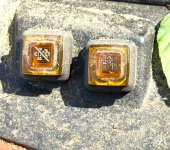Recently replaced our smaller Kubota farm tractor for this new (used) L3901 (2018) that only has 169 hours on it.
My wife mowed on it with zero issues for about 3 hours. As you can see we are in the middle of a pasture reclamation project, so you can get a sense that this is a heavy, fairly constant load. The pasture on the other side of our creek is even higher with even more growth.
First 3 hours of cuts, no problem.
After the 3 hours it began to overhear and the EM light kicked on. That's when the problems began...
First, here's our cutting behavior SINCE it kicked on:
1). Mowing on medium speed with the deck a good 4-5 inches off the ground.
2). RPM's over 2500
3). Going slow-ish on Medium speed
4). Stopping every 15-20 minutes and blowing out the all the cutting particulates that are catching next to the radiator.
5). We've removed the new air filter and blown it out
Finally, I am brand new to the regen process. Our old tractor did not have the regen feature and I am wondering if it just needs to be regen'ed? I will say, however, when the tractor cools, the light does turn off.
Finally, it's never getting "in the red" on the temperature thermostat, but it's definitely running 2/3 'hot.'
Oh - and to regen... I put on the parking brake, let it run over 2k RPM's and then hold down the button on the right for a few seconds and the regen process should kick off/take over?
Any guidance or help would be greatly appreciated. I don't want to have to take it into the dealer if this is something we can do ourselves.
THANK YOU!!
My wife mowed on it with zero issues for about 3 hours. As you can see we are in the middle of a pasture reclamation project, so you can get a sense that this is a heavy, fairly constant load. The pasture on the other side of our creek is even higher with even more growth.
First 3 hours of cuts, no problem.
After the 3 hours it began to overhear and the EM light kicked on. That's when the problems began...
First, here's our cutting behavior SINCE it kicked on:
1). Mowing on medium speed with the deck a good 4-5 inches off the ground.
2). RPM's over 2500
3). Going slow-ish on Medium speed
4). Stopping every 15-20 minutes and blowing out the all the cutting particulates that are catching next to the radiator.
5). We've removed the new air filter and blown it out
Finally, I am brand new to the regen process. Our old tractor did not have the regen feature and I am wondering if it just needs to be regen'ed? I will say, however, when the tractor cools, the light does turn off.
Finally, it's never getting "in the red" on the temperature thermostat, but it's definitely running 2/3 'hot.'
Oh - and to regen... I put on the parking brake, let it run over 2k RPM's and then hold down the button on the right for a few seconds and the regen process should kick off/take over?
Any guidance or help would be greatly appreciated. I don't want to have to take it into the dealer if this is something we can do ourselves.
THANK YOU!!




